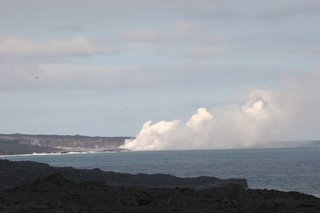Tuesday, February 28, 2006
Hilo: Saturday, February 25
Saturday we drove up Rt. 11 from Hilo to Volcano National Park, a most unusual place. Kilauea is not a mountain but a caldera on the flanks of Moana Loa, and although towering fountains of lava were emitted from the main Kileaua caldera in 1959, most of the volcano’s recent productions have issued from vents below this caldera. Saturday’s expedition brought back vivid but somewhat fuzzy memories of our visit here 15 years earlier. At that time, lava was flowing down the flank of Kilauea and crossing (and blocking) the lowest part of the the Chain of Craters Road, down near the ocean. In 1990 we were able to walk over the previous day’s smooth, glassy pahoehoe, only feet away from the newest red-hot lava. Our sneakers became uncomfortably hot from the red lava running only inches beneath the hard black surface lava, grass burned around the edges of the flow, and towering clouds of steam rose where large tongues of lava spilled into the ocean. A large flow in April, 2003, however, blocked the section of the Chain of Craters Road where visitors had previously parked, so now we were unable to get very close to the flowing lava. Saturday, after hiking a mile from the parking area near the shore we climbed onto a shelf of 2003 lava, from which we could see the bottom of the giant steam plume a mile away, and by holding our binoculars steady we could see red lava entering the sea.
We also drove around most of the main Kilauea caldera on the rim road, looking at the volcano’s many craters, now plugged with 50 or 60 feet of solid lava floating above a reservoir of molten rock. These lava plugs, which are covered with steaming vents, are slowly subsiding, leaving successive “bathtub rings” on the sulfur-coated crater walls. We walked across part of the caldera floor among sulfurous vents, clambering over large slabs of lava, peering down into the main crater, and looking at small ohia lehue plants that were colonizing the old lava. In many areas of the park, roads cross old lava flows whose dates (1969, 1974, 1982, etc.) are posted on signs.
We revisited the Thurston Lava tube and took a ranger-led walk through the rainforest on the caldera rim. This forest is dominated by short red-blossomed ohia lehue trees and by several large, odd ferns, including tree ferns. The woods are animated by large numbers of Apapene, an endemic Hawaiian honeycreeper whose pleasant calls and bright red plumage create a very attractive atmosphere. These birds, along with the remaining survivors of the great Hawaiian honeycreeper radiation, are mostly limited to elevations above the frost line at 4,000 feet, since the introduced mosquitos that carry the introduced avian pox and avian malaria parasite, cannot survive above this level. The imported Indian Mongoose, which eats ground-nesting birds throughout the main islands (except Kauai), does not occur at these eleveations. We saw another Hawaiian endemic, the nene, an endangered goose that survives today only in scattered locations on Hawaii, Kauai, and Maui. Fog and clouds covered the nearby peaks of Moana Kea and Moana Loa, and an occasional drizzle kept the woods moist. Even atop Kilauea, however, the air was pleasantly warm.







We also drove around most of the main Kilauea caldera on the rim road, looking at the volcano’s many craters, now plugged with 50 or 60 feet of solid lava floating above a reservoir of molten rock. These lava plugs, which are covered with steaming vents, are slowly subsiding, leaving successive “bathtub rings” on the sulfur-coated crater walls. We walked across part of the caldera floor among sulfurous vents, clambering over large slabs of lava, peering down into the main crater, and looking at small ohia lehue plants that were colonizing the old lava. In many areas of the park, roads cross old lava flows whose dates (1969, 1974, 1982, etc.) are posted on signs.
We revisited the Thurston Lava tube and took a ranger-led walk through the rainforest on the caldera rim. This forest is dominated by short red-blossomed ohia lehue trees and by several large, odd ferns, including tree ferns. The woods are animated by large numbers of Apapene, an endemic Hawaiian honeycreeper whose pleasant calls and bright red plumage create a very attractive atmosphere. These birds, along with the remaining survivors of the great Hawaiian honeycreeper radiation, are mostly limited to elevations above the frost line at 4,000 feet, since the introduced mosquitos that carry the introduced avian pox and avian malaria parasite, cannot survive above this level. The imported Indian Mongoose, which eats ground-nesting birds throughout the main islands (except Kauai), does not occur at these eleveations. We saw another Hawaiian endemic, the nene, an endangered goose that survives today only in scattered locations on Hawaii, Kauai, and Maui. Fog and clouds covered the nearby peaks of Moana Kea and Moana Loa, and an occasional drizzle kept the woods moist. Even atop Kilauea, however, the air was pleasantly warm.






